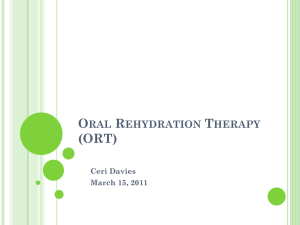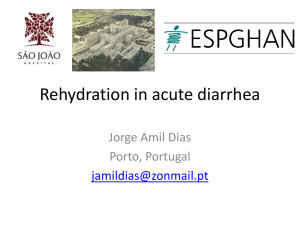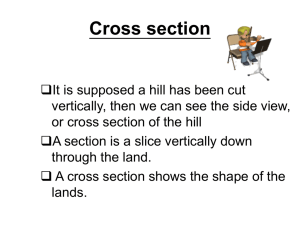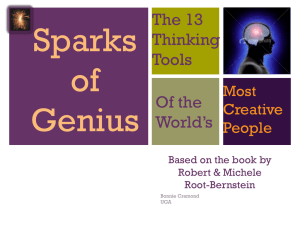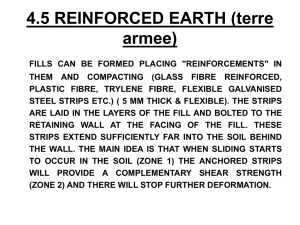Passive and Active Rehydration
advertisement
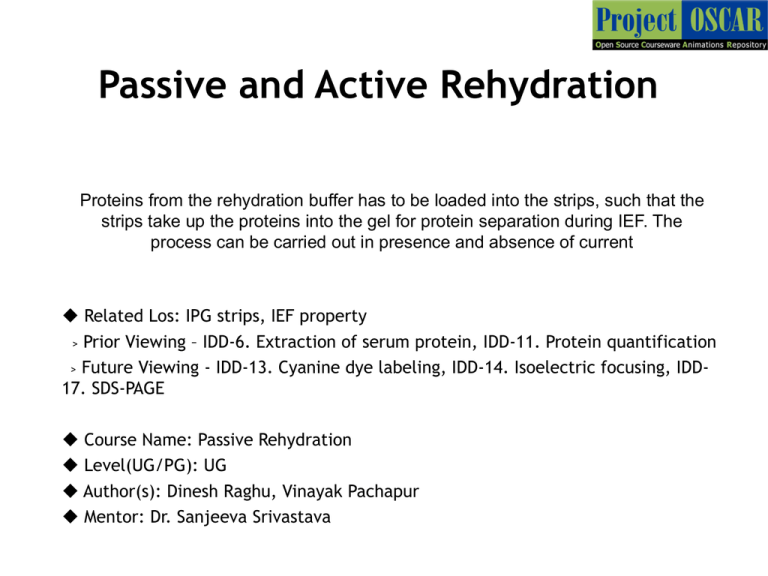
Passive and Active Rehydration Proteins from the rehydration buffer has to be loaded into the strips, such that the strips take up the proteins into the gel for protein separation during IEF. The process can be carried out in presence and absence of current Related Los: IPG strips, IEF property > Prior Viewing – IDD-6. Extraction of serum protein, IDD-11. Protein quantification > Future Viewing - IDD-13. Cyanine dye labeling, IDD-14. Isoelectric focusing, IDD17. SDS-PAGE Course Name: Passive Rehydration Level(UG/PG): UG Author(s): Dinesh Raghu, Vinayak Pachapur Mentor: Dr. Sanjeeva Srivastava 1 2 Learning objectives After interacting with this learning object, the learner will be able to: 1. 3 2. 3. 4 5 4. Indentify steps involved in the passive and active rehydration. Determine the importance of passive & active rehydration. Infer the steps involved to perform the experiment. Assess the troubleshooting steps involved in the experiments. 1 Master Layout Cleaning and Drying (Slide:5) 2 Preparation of rehydration solution (Slide:6-8) Sample addition (Slide:9) Sample loading (Slide:10) 3 Overlay of Strips (Slide:11-12) Application of Cover Fluid (Slide:13) 4 Passive rehydration (Slide:14) Active rehydration (Slide:15-17) 5 Animate two process one for passive and other for active, only final step is different. 1 Definitions and Keywords 1. Protein : Proteins are the biomolecules, composed of amino acid, forming the building block of the system and performs most of the biological functions of the system. 2. IPG strips: Immobilized pH Gradient strips consists of immobilines with that helps in maintaining the pH 2 gradients which is exploited for protein separation. 3. IPG buffer: Buffer consists of immobilines which aid in conductance, maintain the stability of separated proteins 4. Rehydration buffer: A cocktail of reagents used for sample solubalization and used for sample storage. a)Dithiothreitol: Constituent of rehydration buffer used to reduce the disulfide bonds in the protein. 3 b)CHAPS: is a zwitter-ionic detergent, constituent of rehydration buffer that is used to solubilize the proteins including membrane proteins. c) Urea: It is a organic compound in rehydration buffer that is used to denature protein. d)Bromophenol blue: Used in rehydration as color marker and acid –base indicator 5. Cover fluid: Cover fluid prevent evaporation of the sample. 4 6. IPGphor IEF instrument: The instrument used for the first dimension separation. It consists of electrodes with positive and negative terminal with the protocol setting options that can aid in user friendly usage. 7. Passive rehydration: the process of letting the IPG strip to swell with protein sample kept at longer time without applying current. 5 8. Active rehydration: the process of letting the IPG strip to swell with protein sample kept at defined time with applying current. 1 Step 1: T1:Cleaning and Drying Reswelling tray 2 manifold electrode unit 3 4 5 Description of the action/ interactivity Draw a reswelling tray, manifold unit, a hand picture, tissue paper. Instruct to click on hand, place it on the tray to make a movements for cleaning. Movements should happen when the user clicks on hand. Draw tray image with water droplets, later after cleaning with tissue it should be dry and clean. Please re-draw the figure from wet to final dry image. Please repeat the same steps on manifold electrode unit for active rehydration. Audio Narration (if any) Place the tray/manifold on the table. Clean all the lanes of tray/manifold with tissue paper, to make it free from dust and dry it completely before use. 1 Step 2: T2: Preparation of rehydration solution 2 3 Description of the action 4 5 Show a measuring balance. A hand action when clicked by user should ON the Instrument, pick paper from rack, place it on the balance so that balance reads 0.03g and the user should press ”0” on the balance to make the reading to “0.00”. Let user tare the balance with paper, before weighing the reagent. Audio Narration (if any) Clean the surface of the balance, Tare the weight of the paper before weighing. 1 2 3 4 5 Step 2: T2: Preparation of rehydration Solution Description of the action The animator should draw bottles labeled as CHAPS, urea, dithiothreitol, bromophenol blue, distilled water, a empty rehydration solution labelled eppendroff tube and a spoon. Instruct user to click on CHAPS bottle, unscrew it and take out the powder with help of spoon to weigh 0.02g followed by urea bottle (0.48g), dithiothreitol (0.62g), let user takes the pipette set it to 25ul to add bromophenol blue and 1000ul (microlitre) to add distilled water to the rehydration solution bottle. Color of solution should change after addition of bromophenol blue from colorless to blue color. For more information on preparation refer to slide:8 of IDD-2. Extraction of plant protein. Audio Narration Weigh 8M urea, 2%CHAPS, 40mM Dithiothreitol and add 1%bromophenol blue followed by 1ml of distilled water. 1 Step 3: T2: Preparation of rehydration solution 2 Image/graphic for the step 3 4 5 Description of the action Draw a vortex as shown in figure, user must position rehydration solution tube on rubber pad of vortex as shown in figure. Hand action click on the “start” button and speed knob should regulate the speed of vortex manually. Audio Narration Vortex the tube till, the solution mixes well for even distribution. 1 2 3 4 5 Step 3: T3:Sample addition Description of the action The animator should show sample tube, rehydration solution tube, IPG buffer and an empty tube. Instruct user to set the pipette to 5ul and add 5ul IPG buffer to empty tube, set pipette to 300ul to take sample to pipette out into empty tube. Later set the pipette to 200ul and draw 200ul of rehydration buffer to add to make total volume 500 ul. Animate to keep on increasing the level in empty tube after each addition, now tube is ready for brief vortex. During vortex make color change of solution in empty tube to blue color that of rehydration solution. Vortex as shown in previous slide Audio Narration Prepare the sample for loading it in the strip equivalent to 600ug protein concentration for 18cm strip. In case user is loading for 7cms and 24cms, user can calculate accordingly depending upon sample availability. 1 Step 4: T4: Sample Loading 2 3 Passive rehydration Active rehydration Description of the action/ interactivity 4 5 After the vortex, take out and zoom the tube and instruct the user to draw the solution from tube with pipette and spread it evenly in single lane of reswelling tray/manifold. Please redraw the figure with animation. The user should click and drag the pipette to put the sample in the lane. Audio Narration (if any) Load the sample in the reswelling tray/maifold in one shot, avoid air bubbles. Even distribution of the sample must be there and care must be taken the length of distribution must be match length of the strip. 1 Step 5: T5:Overlay of Strips 2 3 Description of the action 4 5 Audio Narration The animator should draw a freezer named as Remove the strip from -20’C an 20’C and a box inside that labeled as IPG strips allow it to thaw for 5minutes, before 18cm (4-7 pI). The user should open the door and laying over the sample. take out the strip pack from the box as shown in figure. And animate like keeping the strips in room temperature for 5minutes. Redraw the figure 1 Step 6: T5:Overlay of Strips 2 3 Passive rehydration Active rehydration Description of the action 4 5 User must take out the packing cover, with the help of forceps the strip must be taken out from the packing. Take out the strip with forceps and in other hand with the help of another forcep remove plastic cover from the top of the strip as the user takes it out. Zoom to the strip to show the gel coating and keep the strip on the top of the sample by keeping gel side down to contact with sample. The strip must be laid with the side where the cover was struck, to show gel side down and lay over the sample solution in the lane at one go. Show clock for 30min. Audio Narration Place the strip on the reswelling tray in contact with the sample with the gel side facing down and keep it for half an hour 1 Step 7: T6: Application of Cover Fluid 2 3 4 5 Passive rehydration Description of the action/ interactivity After 30-60minutes, show a tube labeled as cover fluid and the user should click on pipette to take out 1ml cover fluid and pipette out along the strip as the user click and drag the pipette as shown in figure. Active rehydration Audio Narration (if any) Add cover fluid to the strip to prevent evaporation. While adding avoid air bubbles. The strip must be covered with oil. 1 2 3 4 5 Step 8: T7: Passive Rehydration Description of the action The animator should show a clock running for 16hrs for overnight rehydration. Audio Narration Overnight process helps the IPG strip to get rehydrated with protein sample in the absence of electric field. Once the passive rehydaration is over, the strip is ready for IEF run. Please refer the IDD of IEF. 1 Step 9: T7: Active Rehydration 2 3 4 5 single electrode manifold unit Description of the action/ interactivity For active rehydration. Sample loading and taking out IPG strip like in slide: 10, 11, 12 and 13. instead of using the re-swelling tray user must use manifold for active rehydration. cover the electrode with plastic plate soon after pouring the cover strip oil. Now transfer the assembly to IEF instrument. Strip gel side facing down Cover Strip oil Audio Narration (if any) Only difference in active rehydration In active rehydration, sample is loaded in a is single electrode manifold unit in case of single strip or strip loaded into manifold directly if many strips are there. Unlike using of rehydration tray like in passive rehydration, for active rehydration manifold is used. The amount of cover strip oil laid is saved. The wicks are also saved. 1 Step 9: T7: Active Rehydration Instead of manifold tray on the instrument please re-draw the figure to keep single manifold electrode unit. 2 3 4 5 HV ON light Description of the action/ interactivity Let user takes the electrode assembly and keeps it on the instrument. Place the plastic support over the electrode assembly. Let user close the lid of the IPG phor and ON the instrument. The instrument goes in for calibration check, animate this on display and after calibration glow the HV ON light. Audio Narration (if any) The electrode assembly are held together and placed at the correct position by the plastic support. The system goes in for automatic calibration for display, buzzer and light to check for working condition. Step 9: T7: Active Rehydration 1 2 3 4 5 Description of the action/ interactivity Show the instrument connected with monitor with desktop display. The user should click on icon “IPGphor” the window should appear as shown. Let user have control over selecting the protocol, number of strip, pH range, set the voltage and run time for the step-1. let user connect the instrument and transfer the protocol to the IPG phor instrument by clicking on Play. Audio Narration (if any) Connect the instrument properly. ON the system and Select active rehydration protocol for 5hrs at 20V/50mA for each strip. Now after the active rehydration step user can include 1D focusing parameters also. Do check future viewing IDD for more information. Slide 5 Tab01 Slide 68 Tab 02 Slide 9 Tab 03 Slide 10 Slide 11-12 Tab 04 Tab 05 Slide 13 Tab 06 Slide 14 Tab 07 Slide 15-17 Tab 08 Name of the section/stage: 16, 17, 18 Animation area In Slide-16: if user place the wicks on the strip backing support rather then on the gel and proceeds the setup. Instruction: Display on monitor a very low voltage attained with comparison to set voltage and instruct user to check the setup again to place the wicks properly on the gel. In Slide-17: while applying the cover fluid, in a hurry or to test the equipment, let user pour the fluid to a lesser quantity and proceeds with the setup. Interactivity area Button 01 Button 02 Button 03 Instruction: Display on monitor a very low voltage attained with comparison to set voltage and instruct user to check the setup again to pour sufficient fluid to cover the strip and the fluid level making contact with electrode. In Slide-18: if user place the electrode away from the strip and not exactly on the wicks and proceeds the setup. Instruction: Display on monitor a very low voltage attained with comparison to set voltage and instruct user to check the setup again to place the electrode properly on the wick and the wick making contact with the gel end. Instructions/ Working area Credits APPENDIX 1 Questionnaire: 1)Passive rehydration denotes a)Movement of protein from the rehydration buffer to the IPG strip Gel with help of electric field b)Movement of protein from the rehydration buffer to the IPG strip Gel without electric field c)Movement of protein from one IPG Strip to the other with help of electric field d)Time to denature protein in the strip Answer:Movement of protein from the rehydration buffer to the IPG strip Gel without electric field APPENDIX 1 Questionnaire: 2)Purpose of IPG buffer a)Prevent protein renaturation b)Prevent protein denaturation c) Maintains conductance during separation d)All the above Answer: c)Maintains conductance during separation 3)IPG strips means a)Immobilized pH gradient b)Ion-Protein gradient c)Ionized protein gel d)Ion-protein gel Answer: a)Immobilized pH gradient APPENDIX 1 Questionnaire: Question 4 IPG strips are used for a)Protein stability b)Protein separation based on pI c)Protein separation based on Molecular weight d)Protein separation based on amino acid composition Answer:b)Protein separation based on pI APPENDIX 1 Questionnaire: Question 5 Cover fluid prevents a)Protein denaturation b) Evaporation of the sample c)Conductance d)Gel from melting during separation Answer:b) Evaporation of the sample APPENDIX 2 Links for further reading Reference websites: 2DE Tutorials by Angelika Görg : http://www.wzw.tum.de/blm/deg/ Books: GE Handbook 2D-Electrophoresis: principle and methods Biochemistry by Stryer et al., 5th edition Biochemistry by A.L.Lehninger et al., 3rd edition Biochemistry by Voet & Voet, 3rd edition Research papers: Chen JH, Chang YW, Yao CW et al. Plasma proteome of severe acute respiratory syndrome analyzed by two-dimensional gel electrophoresis and mass spectrometry.Proc Natl Acad Sci U S A2004, 7;101(49):17039-44. Eymann C, Dreisbach A, Albrecht D. A comprehensive proteome map of growing Bacillus subtilis cells. Maldonado AM, Echevarría-Zomeño S, Jean-Baptiste S. et al. Evaluation of three different protocols of protein extraction for Arabidopsis thaliana leaf proteome analysis by two-dimensional electrophoresis. Proteomics 2008, 71(4):461-72. APPENDIX 3 Summary The experiment involves the sample preparation, loading the sample in strip and overnight incubation. Enough time must be given for the protein to diffuse into the strips and occupy the gel in the strips. The strips will be swollen after rehydration and looks blue as the rehydration enter the strips along with the proteins. Care should be taken to prevent the bubble formation between the strip and the sample. Avoid crystal formation and evaporation by covering the strip with cover fluid


